For years, workout programs have featured the abdominal crunch (and all of its variations) with the intention of trying to strengthen the muscles responsible for controlling movement around your body’s center of gravity. To understand how we should approach strengthening the core, it is important to recognize that many muscles are positioned to function optimally when the body is standing upright.
Consider a child learning how to walk, which typically happens in the first nine to 14 months of life. It takes this long because the muscles that control motion in the hips, shoulders, legs and spine have to develop the strength and ability to function together as an integrated system. In other words, these muscles are not designed to work in isolation, so they shouldn’t be trained that way. The human musculoskeletal system is structurally designed to work most efficiently when standing upright. To learn more about how the muscular system, specifically the abdominals, is designed to function, check out these previous articles HERE and HERE.
Just because we’ve done something a certain way in the past does not mean we need to continue following that tradition, especially if there are better, more biomechanically efficient ways to strengthen the core muscles. For example, a good strength-training workout for the core muscles is almost indistinguishable from a total-body workout. The only difference might be asymmetrical loading (using only one body part at a time). Using only one arm or leg at a time is a simple, yet effective strategy for engaging the muscles responsible for stabilizing your spine and hips, while increasing the level of difficulty for core fitness training. If you’re looking for some new nontraditional exercises to strengthen the core, here are seven moves to consider.
Kettlebell Windmill
Stand with the feet a little wider than hip-width apart, with the left foot forward at the 12 o’clock position and the right foot at about the 4 o’clock position. The toes on both feet should be pointing the same direction. Hold a kettlebell in the left hand so that it is resting along the inside of the left thigh; hold the right arm extended straight up. To start the move, keep both knees slightly bent, turn your head to look up at the right arm and push back into the right hip. Keep the spine long and straight while looking at the right hand and hinging forward, allowing the kettlebell to slowly lower toward the ground. Once it is no longer possible to hinge forward at the hips (the spine will start to move), push the hips forward and pull back up to standing using the glutes. The movement speed should be slow and controlled, about two to four seconds in each direction. Complete four to six reps before switching sides; rest 30-45 seconds between sets. Start with two sets and work up to doing four sets on each side. Because the movement comes from the hips and not the spine, it is best to start with the weight in a low position so it pulls you down into the movement. Once you feel comfortable with the hinging motion, progress to holding the kettlebell in the right arm over your head. This will cause the weight to push you down into the movement as opposed to pulling you into the motion.
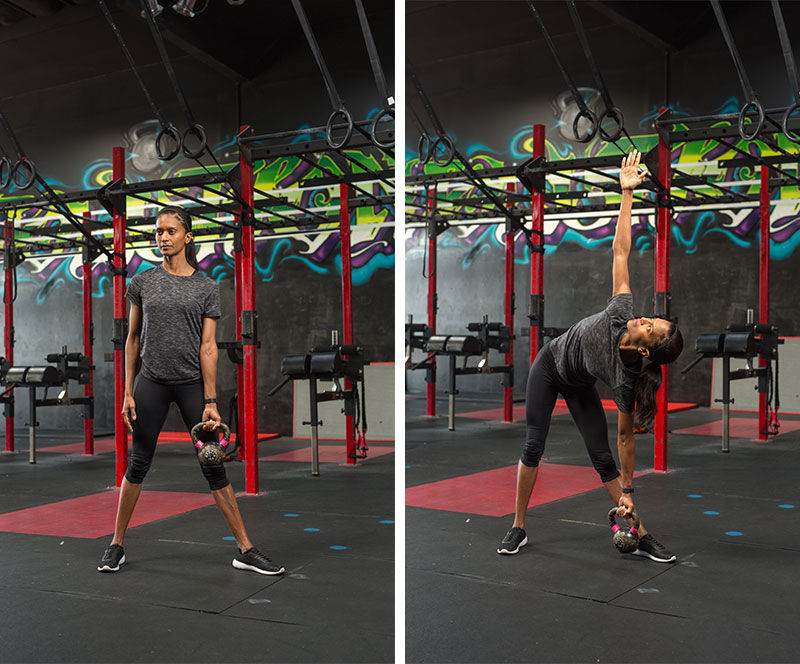
Kettlebell Overhead Carry
With the right hand, grip a kettlebell in a standard racked position. Extend the right arm directly overhead so that the palm is facing the midline of the body. Keep the arm extended overhead and walk forward approximately 20 to 25 feet. Turn around and walk back to the start; switch arms. Use a weight that makes it challenging to walk the distance while keeping the arm extended. Complete two to four sets and rest 30 to 45 seconds between sets. (To understand the benefits of the overhead carry, read this article on the functional anatomy of the shoulder.)
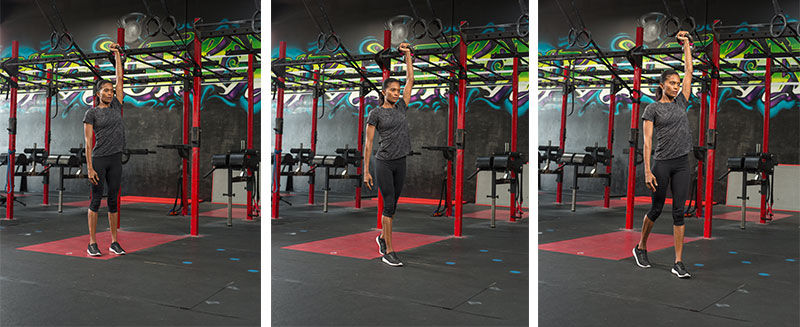
Kettlebell Reverse Lunge to Balance With Offset Hold
Stand in a stable position with feet hip-width apart. Hold a kettlebell in the right hand and step back with the right leg. Keep the spine straight and lean forward slightly while slowly lowering into the left hip. To return to standing, push the left foot into the floor and pull the left knee back to help extend the knee and hip as you bring the right leg forward. For an extra challenge, hold a balance position on the left leg for three to five seconds once you return to standing position and before starting the next repetition. Perform eight to 10 reps on the left hip before switching legs; rest 45 to 60 seconds before the next set. For best results, start with two sets of eight and work up to four sets of 10.
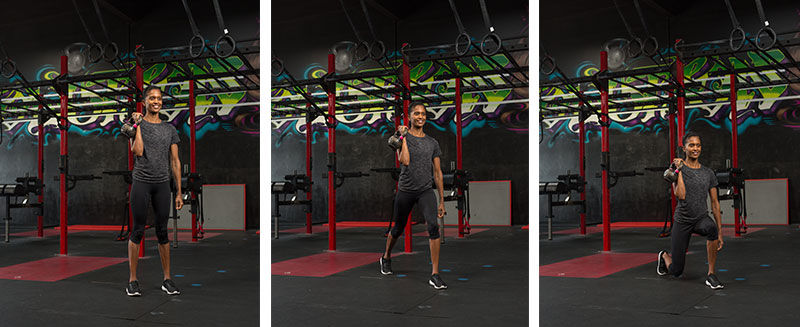
Kettlebell Turkish Get-up
Lie on your right side and hold the kettlebell with both hands so that the right hand is wrapped around the handle and the left hand is on top. Pull the kettlebell close to the body as you roll on your back and extend both arms to lift the kettlebell over your chest. Release the left hand and lay the left arm along your left side at an approximately 45-degree angle. Bend the right knee and place the right foot flat on the floor. Throughout the entire movement, maintain a strong, tight grip on the kettlebell as if you’re trying to squeeze water out of a sponge. Roll on to the left elbow by lifting the right shoulder off the floor as you curl your trunk to finish resting on your left elbow. From your left elbow, push your left hand into the floor as you maintain a straight spine and come up to an almost seated position while keeping the right foot pressed on to the floor. Next, push the right foot into the floor to extend the right hip as you straighten the left arm and lift the left hip so that both hips are off the floor. Push the hips into full extension while leaning on the left arm. For the sweep, hold the bridge position with your right foot pressing into the floor and bring the left leg back and place the left knee on the floor. During this phase, the arms should form a straight line from the floor up to the kettlebell to ensure optimal strength and stability of the shoulder girdle. Remove the left hand from the floor as you move into a kneeling position with the left knee and right foot on the floor. Continue to hold the right arm overhead as you press the right foot into the floor and swing the left leg forward (performing a lunge) to bring the feet next to one another. To return to the floor, step back with the left leg and slowly lower to a kneeling position. Place the left hand on the floor and move the left leg to the front of your body as you hold the bridge position between the left hand and right foot. Slowly lower the hips to the floor before rolling all the way back to a supine (face-up) position. Start with a very light weight to learn the movement. Once you can easily perform four to five reps, add more weight. Complete four to six reps on each side, rest for 60 seconds and work up to completing three sets. For more comprehensive instructions along with a video demonstration, check out this CERTIFIED article on the Turkish get-up.
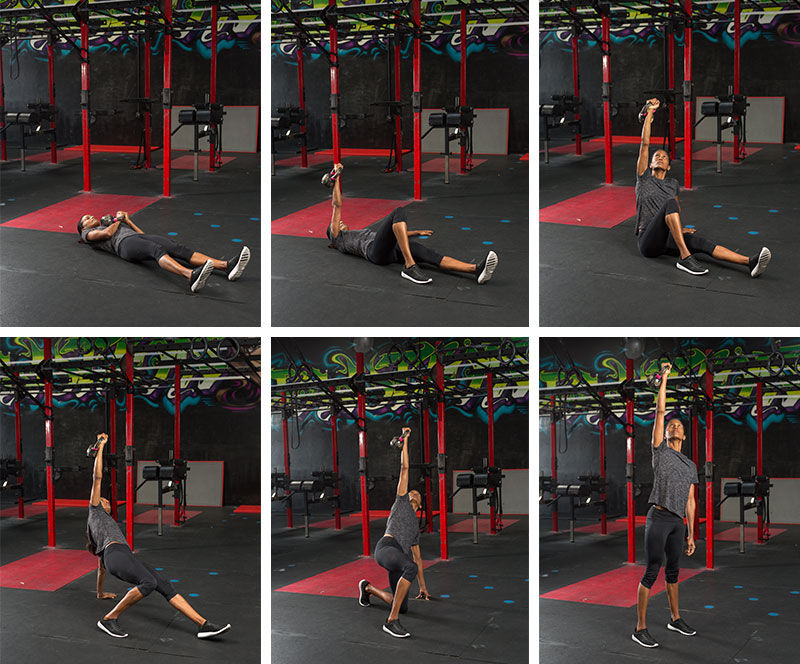
Cable Machine Transverse Lunge to Chop
The cable machine offers many unique, nontraditional ways to strengthen the core muscles. This exercise recruits the muscles of the shoulders, trunk and hips in one, single move. Set the cable pulley higher than head height and grip the handle between both hands so the fingers are interlocked. Keep the arms straight as you push back with the left leg while stepping to the 3 o’clock position with the right foot. As your right foot hits the floor, press the foot down for stability and rotate to the right while keeping the spine long and straight. Return to standing and switch sides. Complete eight to 10 reps on each side, resting for 45 to 60 seconds before switching sides. Complete a total of two to four sets.
Diagonal Raise With Single-leg Balance
Stand tall with the feet about hip-width apart. Hold a light dumbbell in your right hand so that it is resting in front of your left hip. Press the left foot into the floor and lift the right leg so you are balancing on your left leg (you can touch the floor with your right foot, if necessary, but try to keep all of your weight on your left leg). Raise the right arm directly out to the side so that it is extended completely to your right (your hand should be the same height or slightly lower than your right shoulder). Return your right hand to the starting position. Complete eight to 10 reps using the right hand while balanced on the left leg, and then switch sides. Rest about 60 seconds between sets and work up to doing four sets on each side.
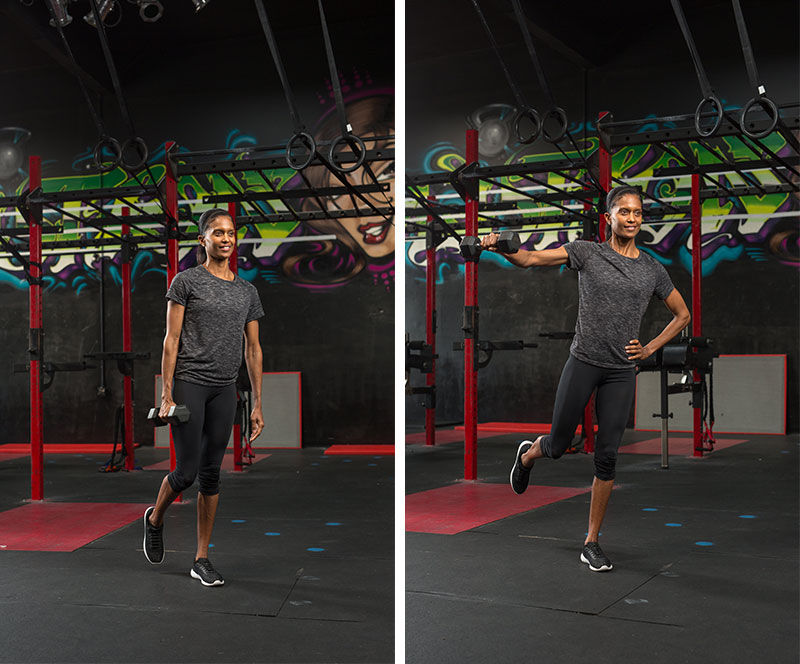
Single-leg Squat to Overhead Press
Hold a light-to-moderate weight dumbbell in your right hand. Press the left foot into the floor so that you are balancing on your left leg (you can lightly touch the floor with your right foot, but try to keep your body weight in your left leg throughout the entire movement). Hinge back into the left hip and lower into a squat with the left leg as you reach for your left foot with the weight in your right hand (reaching across your body will increase the activation of your left glutes). To return to standing, press the left foot into the floor and straighten the left leg. As you return to standing, remain balanced on your left leg while you perform a biceps curl by bringing the weight to your right shoulder. Next, extend your right arm to press the weight overhead. Start with four to six reps and work up to eight to 10 reps before increasing the amount of weight you use. Rest 45 to 60 seconds after completing reps on both legs; start with two sets and work up to four on each leg.
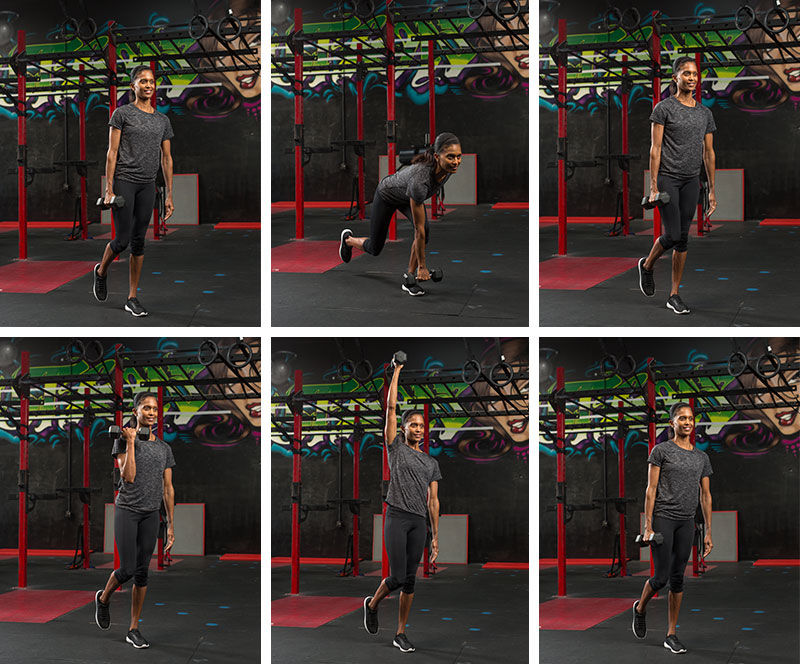
The purpose of core strength exercises should be to create a solid foundation for movement in the rest of the body. When it comes to the most effective exercises for strengthening your core muscles, always remember that your hips and shoulders connect to one another via the core muscles. For this reason, any exercises to truly strengthen your core should be performed in a standing position and involve the hips and shoulders working together in a coordinated, synergistic manner.
Continue learning about core fitness exercises you can introduce your clients to with ACE's core training continuing education courses.




 by
by 






 by
by